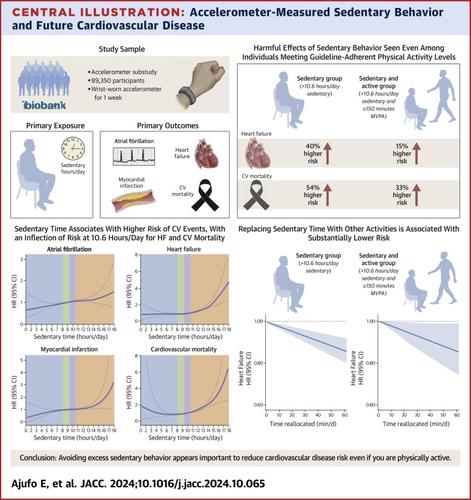当前位置:
X-MOL 学术
›
J. Am. Coll. Cardiol.
›
论文详情
Our official English website, www.x-mol.net, welcomes your
feedback! (Note: you will need to create a separate account there.)
Accelerometer-Measured Sedentary Behavior and Risk of Future Cardiovascular Disease
Journal of the American College of Cardiology ( IF 21.7 ) Pub Date : 2024-11-15 , DOI: 10.1016/j.jacc.2024.10.065 Ezimamaka Ajufo, Shinwan Kany, Joel T. Rämö, Timothy W. Churchill, J. Sawalla Guseh, Krishna G. Aragam, Patrick T. Ellinor, Shaan Khurshid
中文翻译:

加速度计测量的久坐行为和未来心血管疾病的风险
除了作为身体活动不足的标志外,久坐行为还可能直接影响未来的心血管 (CV) 疾病风险。
本研究旨在检查加速度计测量的久坐行为与特定 CV 结果风险之间的关联,包括与中度至剧烈体力活动 (MVPA) 的潜在关系。
在英国生物样本库前瞻性队列研究的参与者中,我们拟合了针对人口统计学和生活方式因素进行调整的 Cox 模型,以评估加速度计测量的每日久坐时间与心房颤动 (AF)、心肌梗死 (MI)、心力衰竭 (HF) 和 CV 死亡率之间的关联。我们通过将 MVPA 作为调整变量,以及按照指南推荐的 MVPA 阈值 (即 ≥150 min/wk) 进行分层亚组分析,评估了 MVPA 对久坐时间和 CV 疾病之间关联的潜在影响。然后,我们进行了成分分析,以估计将久坐时间重新分配给其他活动的影响。
在接受 1 周加速度测量的 89,530 人 (年龄 62 ± 8 岁,56.4% 为女性) 中,中位久坐时间为 9.4 小时/天 (Q1-Q3: 8.2-10.6)。在多变量模型中,使用第二个四分位数 (8.2-9.4 h/d) 作为指涉,在前四分位数 (x3E10.6 h/d) 久坐时间与 HF (HR: 1.45;95% CI: 1.28-1.65) 和 CV 死亡率 (HR: 1.62;95% CI: 1.34-1.96) 的较高风险相关,风险拐点为 10.6 h/d。久坐时间的增加也与事件 AF (HR: 1.11;95% CI: 1.01-1.21) 和 MI (HR: 1.15;95% CI: 1.00-1.32) 的风险增加相关,大致呈线性关系。在达到指南推荐的 MVPA 水平的个体中,与 HF 和 CV 死亡率的关联持续存在。在久坐时间 >10.6 h/d 的个体中,将久坐行为重新分配给其他活动大大降低了久坐行为赋予的额外 CV 风险(例如,HF 久坐时间减少 30 分钟:HR:HR:0.93;95% CI:0.90-0.96),即使在满足指南推荐的 MVPA (HR: 0.93;95% CI: 0.87-0.99) 的个体中也是如此。
久坐行为与未来的不良 CV 结局广泛相关,对 HF 和 CV 死亡率的影响特别突出,其中风险拐点约为 10.6 h/d。尽管遵循指南的 MVPA 部分降低了过度风险,但即使在身体活跃的个体中,优化久坐行为似乎也很重要。
更新日期:2024-11-15
Journal of the American College of Cardiology ( IF 21.7 ) Pub Date : 2024-11-15 , DOI: 10.1016/j.jacc.2024.10.065 Ezimamaka Ajufo, Shinwan Kany, Joel T. Rämö, Timothy W. Churchill, J. Sawalla Guseh, Krishna G. Aragam, Patrick T. Ellinor, Shaan Khurshid

|
Background
Beyond serving as a marker for insufficient physical activity, sedentary behavior may directly affect future cardiovascular (CV) disease risk.Objectives
This study sought to examine associations between accelerometer-measured sedentary behavior with risk of specific CV outcomes, including potential relations with moderate to vigorous physical activity (MVPA).Methods
Among participants of the UK Biobank prospective cohort study, we fit Cox models adjusted for demographic and lifestyle factors to assess associations between accelerometer-measured daily sedentary time with incident atrial fibrillation (AF), myocardial infarction (MI), heart failure (HF), and CV mortality. We assessed the potential effect of MVPA on associations between sedentary time and CV disease by including MVPA as an adjustment variable, as well as performing subgroup analyses stratified at the guideline-recommended MVPA threshold (ie, ≥150 min/wk). We then performed compositional analyses to estimate the effects of reallocating sedentary time to other activities.Results
Among 89,530 individuals (age 62 ± 8 years, 56.4% women) undergoing 1 week of accelerometry, median sedentary time was 9.4 h/d (Q1-Q3: 8.2-10.6). In multivariable models, using the second quartile (8.2-9.4 h/d) as a referent, sedentary time in the top quartile (>10.6 h/d) was associated with greater risks of HF (HR: 1.45; 95% CI: 1.28-1.65) and CV mortality (HR: 1.62; 95% CI: 1.34-1.96), with an inflection of risk at 10.6 h/d. Higher sedentary time was also associated with greater risks of incident AF (HR: 1.11; 95% CI: 1.01-1.21) and MI (HR: 1.15; 95% CI: 1.00-1.32), with an approximately linear relation. Associations with HF and CV mortality persisted among individuals meeting guideline-recommended MVPA levels. Among individuals with >10.6 h/d of sedentary time, reallocating sedentary behavior to other activities substantially reduced the excess CV risk conferred by sedentary behavior (eg, 30-minute decrease in sedentary time for HF: HR: 0.93; 95% CI: 0.90-0.96), even among individuals meeting guideline-recommended MVPA (HR: 0.93; 95% CI: 0.87-0.99).Conclusions
Sedentary behavior is broadly associated with future adverse CV outcomes, with particularly prominent effects on HF and CV mortality, where risk inflected at approximately 10.6 h/d. Although guideline-adherent MVPA partially mitigates excess risk, optimizing sedentary behavior appears to be important even among physically active individuals.中文翻译:

加速度计测量的久坐行为和未来心血管疾病的风险
背景
除了作为身体活动不足的标志外,久坐行为还可能直接影响未来的心血管 (CV) 疾病风险。
目标
本研究旨在检查加速度计测量的久坐行为与特定 CV 结果风险之间的关联,包括与中度至剧烈体力活动 (MVPA) 的潜在关系。
方法
在英国生物样本库前瞻性队列研究的参与者中,我们拟合了针对人口统计学和生活方式因素进行调整的 Cox 模型,以评估加速度计测量的每日久坐时间与心房颤动 (AF)、心肌梗死 (MI)、心力衰竭 (HF) 和 CV 死亡率之间的关联。我们通过将 MVPA 作为调整变量,以及按照指南推荐的 MVPA 阈值 (即 ≥150 min/wk) 进行分层亚组分析,评估了 MVPA 对久坐时间和 CV 疾病之间关联的潜在影响。然后,我们进行了成分分析,以估计将久坐时间重新分配给其他活动的影响。
结果
在接受 1 周加速度测量的 89,530 人 (年龄 62 ± 8 岁,56.4% 为女性) 中,中位久坐时间为 9.4 小时/天 (Q1-Q3: 8.2-10.6)。在多变量模型中,使用第二个四分位数 (8.2-9.4 h/d) 作为指涉,在前四分位数 (x3E10.6 h/d) 久坐时间与 HF (HR: 1.45;95% CI: 1.28-1.65) 和 CV 死亡率 (HR: 1.62;95% CI: 1.34-1.96) 的较高风险相关,风险拐点为 10.6 h/d。久坐时间的增加也与事件 AF (HR: 1.11;95% CI: 1.01-1.21) 和 MI (HR: 1.15;95% CI: 1.00-1.32) 的风险增加相关,大致呈线性关系。在达到指南推荐的 MVPA 水平的个体中,与 HF 和 CV 死亡率的关联持续存在。在久坐时间 >10.6 h/d 的个体中,将久坐行为重新分配给其他活动大大降低了久坐行为赋予的额外 CV 风险(例如,HF 久坐时间减少 30 分钟:HR:HR:0.93;95% CI:0.90-0.96),即使在满足指南推荐的 MVPA (HR: 0.93;95% CI: 0.87-0.99) 的个体中也是如此。
结论
久坐行为与未来的不良 CV 结局广泛相关,对 HF 和 CV 死亡率的影响特别突出,其中风险拐点约为 10.6 h/d。尽管遵循指南的 MVPA 部分降低了过度风险,但即使在身体活跃的个体中,优化久坐行为似乎也很重要。


















































 京公网安备 11010802027423号
京公网安备 11010802027423号